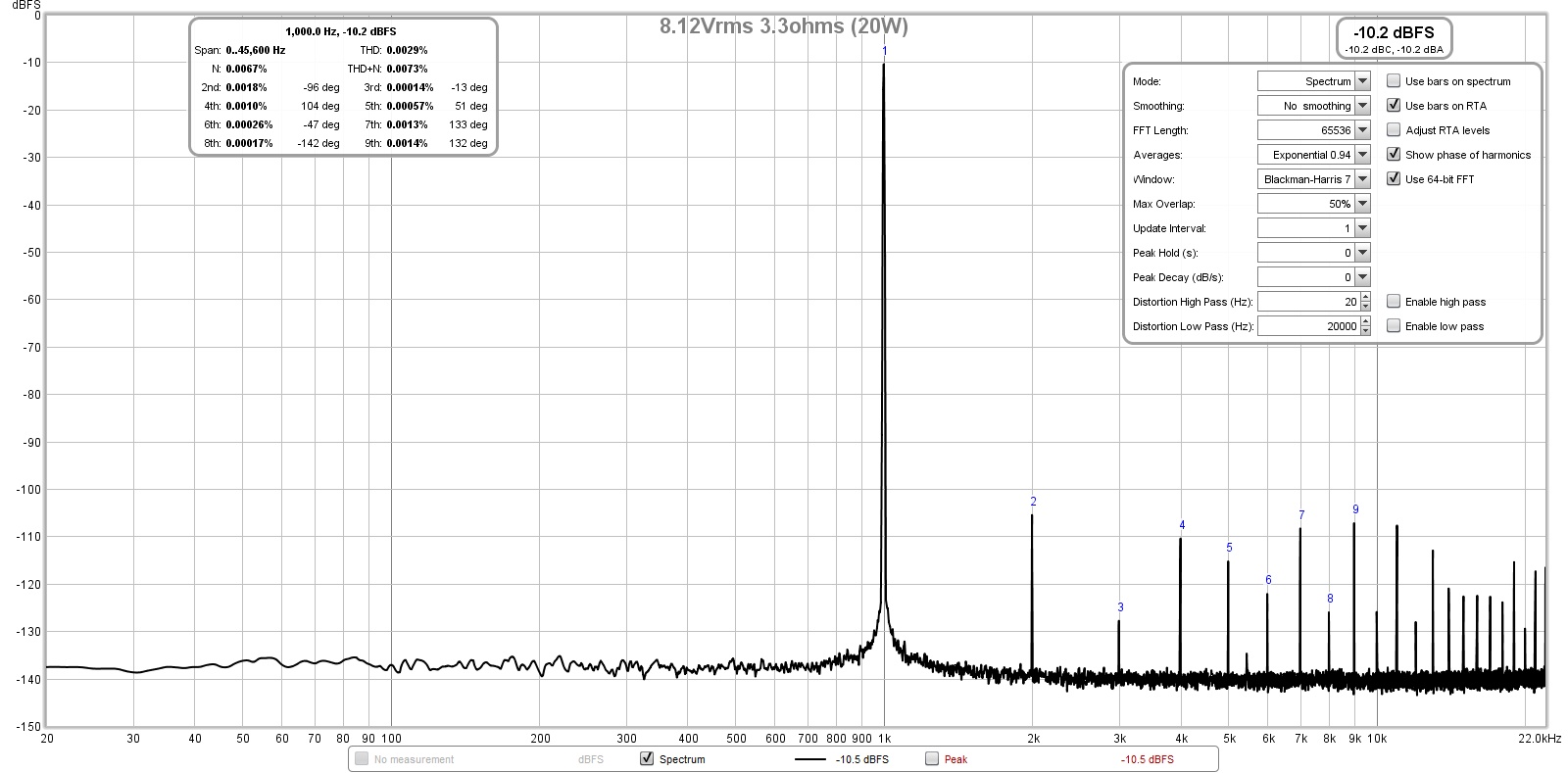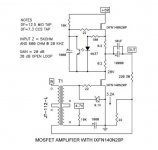I'd just like to poll your opinions about what might be the better natively capable single rail power amp ICs or module designs?
In terms of 'better' I leave that up to you to explain! 😀
It's far easier to find single rail pre-built SMPS PSUs, which is why I'm asking. I appreciate the lack of 50Hz harmonics from SMPS and the small form factor to power ratio.
In terms of 'better' I leave that up to you to explain! 😀
It's far easier to find single rail pre-built SMPS PSUs, which is why I'm asking. I appreciate the lack of 50Hz harmonics from SMPS and the small form factor to power ratio.
What is “best” is always a loaded question and open to interpretation and different requirements.
It sounds like you are looking for a chip amp and not a discrete amp?
If you are looking at chip amps, almost any can be converted to single rail operation with addition of an output coupling cap and revising the rails with reference to ground for single rail output.
Or some chip amps are already in BTL mode and use a single rail supply right off the bat. Like the TDA7297 - discussed extensively in this thread.
The LM3886 has a nice single rail implementation as done in the Akitika kit, although that one still uses a linear, albeit, regulated single rail supply.
But if you want high performance state of the art low noise powerful amp and are opposed to Class D, many offerings from TI in the TPA32xx family fit the bill.
Single rail supply with clean SMPS will give you a flat single digit uV rms noise background.

It sounds like you are looking for a chip amp and not a discrete amp?
If you are looking at chip amps, almost any can be converted to single rail operation with addition of an output coupling cap and revising the rails with reference to ground for single rail output.
Or some chip amps are already in BTL mode and use a single rail supply right off the bat. Like the TDA7297 - discussed extensively in this thread.
The LM3886 has a nice single rail implementation as done in the Akitika kit, although that one still uses a linear, albeit, regulated single rail supply.
But if you want high performance state of the art low noise powerful amp and are opposed to Class D, many offerings from TI in the TPA32xx family fit the bill.
Single rail supply with clean SMPS will give you a flat single digit uV rms noise background.
Last edited:
You may want to peruse this.
https://www.ti.com/lit/an/sloa030a/...03565&ref_url=https%3A%2F%2Fwww.google.com%2F
https://www.ti.com/lit/an/sloa030a/...03565&ref_url=https%3A%2F%2Fwww.google.com%2F
Attachments
If we are going to include SE Class A amps, the field opens up a lot. I would add that IMO, the sound from a well designed SE Class A amp will be superior to anything from a chip amp.
This is also single rail, very simple, and good for 40w of Class A power.
LuFo Amp - 39w SE Class A from 28v Rail
This is also single rail, very simple, and good for 40w of Class A power.
LuFo Amp - 39w SE Class A from 28v Rail
There are other ways to solve the same problem - look at the Quad 306 power amplifier schematic, which uses a single-ended supply, with a small active DC splitter/balancer - for example. No problem with that amp supplying past 5Arms /ch. with very good precision - even though you'd might not believe it at first glance based on the parts uses in the rail-splitter.
The trade-off with OTS smps PSUs will be acheiving your target power output from low voltages, say up to 24VDC.
To attain useful numbers, esp. if you envisage even a little onboard EQ for cabinet design or sim - you are going to likely need a bridge-tied-load style amp. Which will offer approaching 4x peak power as compared with a single -ended amp running off the same 24Vdc with a rail-splitter.
BTL output also offers much neato cancellation of psu ripple via the shared reservoir cap that becomes a common-mode issue; but - you now have two, possibly cheapo, amplifiers in series, and that likely takes-away in equal measure elsewhere unless you are canny.
Nice to see you posting again, Simon - you know where to find me 😉
ATB.
The trade-off with OTS smps PSUs will be acheiving your target power output from low voltages, say up to 24VDC.
To attain useful numbers, esp. if you envisage even a little onboard EQ for cabinet design or sim - you are going to likely need a bridge-tied-load style amp. Which will offer approaching 4x peak power as compared with a single -ended amp running off the same 24Vdc with a rail-splitter.
BTL output also offers much neato cancellation of psu ripple via the shared reservoir cap that becomes a common-mode issue; but - you now have two, possibly cheapo, amplifiers in series, and that likely takes-away in equal measure elsewhere unless you are canny.
Nice to see you posting again, Simon - you know where to find me 😉
ATB.
Last edited:
There are (at least) 3 ways to use a single supply voltage with a typical op-amp style amplifier.:
1. QSC style where the amplifier drives ground and the output is taken from the center of two caps across the supply. ie, the amp drives floating rails. Each channel needs it's own (single) power supply.
2. Ground voltage is set by the amplifier using a divider across the supply to the amp input. Like the QSC, two caps in series are across the power supply. More than one channel can share the supply but separate supply caps is a good idea but not required.
3. Bridged amplifiers where the speaker DC is cancelled by the other side of the bridge. Generally that means the input ground is not the same as the output DC voltage. Many auto stereos operate this way.
Classic single supply amps use a 4. a DC blocking cap in series with the output, or 5. a output transformer.
6. DC-DC converters are easy and cheap in order to create a second voltage. Most "buck converters" can be wired as a voltage inverter.
(Enough for now)
1. QSC style where the amplifier drives ground and the output is taken from the center of two caps across the supply. ie, the amp drives floating rails. Each channel needs it's own (single) power supply.
2. Ground voltage is set by the amplifier using a divider across the supply to the amp input. Like the QSC, two caps in series are across the power supply. More than one channel can share the supply but separate supply caps is a good idea but not required.
3. Bridged amplifiers where the speaker DC is cancelled by the other side of the bridge. Generally that means the input ground is not the same as the output DC voltage. Many auto stereos operate this way.
Classic single supply amps use a 4. a DC blocking cap in series with the output, or 5. a output transformer.
6. DC-DC converters are easy and cheap in order to create a second voltage. Most "buck converters" can be wired as a voltage inverter.
(Enough for now)
Some inspiration from good old examples:
A collection of vintage, single supply, low to medium power amplifiers for Daniel
Here are some examples of my own, with refinements like auto-bias:
Old-fashioned amplifiers with a new twist (1)
Old-fashioned amplifiers with a new twist (2)
Easy-MOS is a simplistic, efficient and evolutive all-MOS amplifier for beginners
A single supply version of the Circlophone also exists:
♫♪ My little cheap Circlophone© ♫♪
A collection of vintage, single supply, low to medium power amplifiers for Daniel
Here are some examples of my own, with refinements like auto-bias:
Old-fashioned amplifiers with a new twist (1)
Old-fashioned amplifiers with a new twist (2)
Easy-MOS is a simplistic, efficient and evolutive all-MOS amplifier for beginners
A single supply version of the Circlophone also exists:
♫♪ My little cheap Circlophone© ♫♪
We cannot determine for you the desired power, load resistance, permissible THD.
Element base - BJT, MOSFET, IC, tube?
Output type - transformer, OCL, bridge?
Amplification class: A, B, AB, D?
SE or PP?
Element base - BJT, MOSFET, IC, tube?
Output type - transformer, OCL, bridge?
Amplification class: A, B, AB, D?
SE or PP?
Last edited:
Dual supply op amps are the same as single rail.
Its all relative.
I tend to use op amps that fit the requirements.
Why use an expensive op amp for something that doesnt need it ?
I tend to use tl064's for gen purpose and r2r for more exotic uses.
Its all relative.
I tend to use op amps that fit the requirements.
Why use an expensive op amp for something that doesnt need it ?
I tend to use tl064's for gen purpose and r2r for more exotic uses.
Nice to hear from you Martin!
Thanks for all the replies everybody.
I didn't want to limit responses by setting power requirements etc.. Just good inspiration to see all the options.
Those TPA32xx series do look very nice, it's good to see that peak in the midrange distortion most cheap class-D amps have is getting under control.
Thanks for all the replies everybody.
I didn't want to limit responses by setting power requirements etc.. Just good inspiration to see all the options.
Those TPA32xx series do look very nice, it's good to see that peak in the midrange distortion most cheap class-D amps have is getting under control.
Dual supply op amps are the same as single rail.
Its all relative.
Well, except the single supply opamps usually handle inputs upto 0.5V below ground, so you don't need to synthesize a mid-rail ground.
Hello girls and boys....
i have two transformers with secondary 0-44VAC - could use them for some power amplifier with single rail psu....
any good ideas...
I was looking at Blomley but seems that it is not capable of driving 4ohm that i have...
thank you
i have two transformers with secondary 0-44VAC - could use them for some power amplifier with single rail psu....
any good ideas...
I was looking at Blomley but seems that it is not capable of driving 4ohm that i have...
thank you
A design from years ago that appeared in Practical Wireless was one that I built and it was a great sounding amp. Its an unusual circuit when you look at the details. Using modern transistors and you would need to add 0.22 or 0.33 ohm emitter resistors to the output transistors. It would suit your 44 volt transformers perfectly.
https://www.diyaudio.com/community/...n-was-it-inspired-or-just-an-also-ran.294153/

https://www.diyaudio.com/community/...n-was-it-inspired-or-just-an-also-ran.294153/
If the transformers are identical, you can easily make it into 44-0-44 vac, which can give you about +/_50 something volt dc.Hello girls and boys....
i have two transformers with secondary 0-44VAC - could use them for some power amplifier with single rail psu....
any good ideas...
I was looking at Blomley but seems that it is not capable of driving 4ohm that i have...
thank you
Then you can make any amp you want.
X has some pcbs in his etsy store. Search 'amp for lean times'.
- Home
- Amplifiers
- Solid State
- Best Single Rail Amps?

